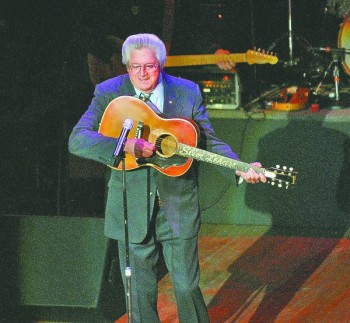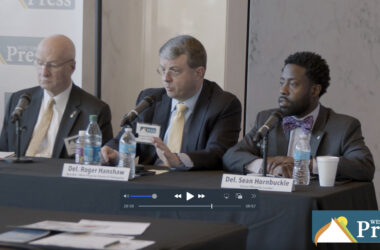
Slim Lehart, “The Wheeling Cat,” performs during the 2009 reopening of the Capitol Theatre. Lehart is being honored Monday with his own sidewalk star at the Capitol’s “Walkway of Stars.”
WHEELING, W.Va. — It’s taken more than three decades, but longtime Jamboree USA star Slim Lehart is finally getting his due.
On Monday, the boisterous local entertainer, known as “The Wheeling Cat” for how he prowled the stage with his trademark guitar, will be honored with a sidewalk star in front of the Capitol Theatre – the first addition to the “Walkway of Stars” since it was created in 1983.
“It’s a nice feeling to be among the major names already out there,” Lehart said, referring to such country music luminaries as Hawkshaw Hawkins, Lee Moore, Doc Williams, Mac Wiseman, Charlie Pride, Grandpa Jones and dozens of other performers.
Impressive company for a Marshall County boy born in the throes of the Great Depression.
Lehart was born Richard Edmund Hartley outside Viola, W.Va. in 1935 and was helping out on the farm as soon as he was able. Chores included milking cows, gathering eggs, slopping hogs and hauling coal for the furnace.
But he didn’t really care for the farming life. It was music that made him tick.
“My family, they all played music,” he said. “My dad played the fiddle and my mom played the piano. I had two brothers and three sisters and they all played some instrument. I played the guitar and I was probably the worst of the bunch.”
His oldest brother eventually bought an old Logan system with a lone microphone. They didn’t have electricity at the farm so they traveled to area square dances and other meetings to perform.
Leaving home at the age of 15, Lehart moved to Wheeling where he worked for a landscaping company. He joined the U.S. Navy at 17 and served during the Korean War. After that he took work wherever he could, driving a truck, remodeling homes, doing road construction and running a bar.
“I’ve worked about everything you can think of,” he said. “I’ve done it all, including playing music. I had a bus and traveled all over the Northeast. Some down south. We had a real great time doing that and a very good learning experience. We was out in the country, you know, where we met all kind of people. And it really was an education.”
He was running a Gulf service station in Tennessee when he encountered an old, bent-over Quaker State salesman with a curious acronym on his tie clip, “Y-C-D-B-S-O-Y-A.”
Lehart asked him what it meant.
“You can’t do business sittin’ on your (backside),” Lehart said. “That’s what those letters were for. Told me you gotta hustle. And he gave me one of those tie clips.”
Taking the old man’s tip to heart, Lehart began pestering Bob Finnigan, the Jamboree director at the time, trying to get a spot on the cast. He didn’t have much luck but kept at it.
Then, one Saturday night in the fall of 1965, he got his chance. It went well and he became a regular guest until 1970 when he signed on as a cast member.
“I was the first one to sign up under the new name, Jamboree USA,” he said. “From then on I was the opening act near every Saturday night. And the reason I was the opening act was I didn’t walk out onto the stage, I ran out onto the stage. I would go out onto the orchestra pit cover. I used to throw roses to the crowd. And I just done all kinds of stuff.”
Lehart quickly developed a following at the Jamboree. Fans were particularly fond of his song, “The Wheeling Cat.” He had it embroidered on the back of his double-vested suit and after he’d perform he’d turn around and flip up the tail to great effect.
He met some of the biggest names in country music in the 1970s and 1980s. (Lehart even has a picture of Johnny Cash playing his custom Slim Lehart guitar.) But perhaps the best part of his Jamboree days was the camaraderie with his fellow cast members. They’d socialize in the downstairs dressing rooms before shows, telling stories and trading tips on where to get paying gigs.
“In the 1970s, after it became Jamboree USA, that’s when the tourism really started,” he said. “There used to be motorcoaches all up and down Main Street like you wouldn’t believe. It was just great.”
Despite his success, Lehart did what he could to earn money on the side. He had an interest in a Wheeling nightclub called Club Madrid and worked out a deal with some Canadian motor coach drivers. He’d hop on their buses at the Dallas Pike truck stop and perform in the aisles. In return, they’d drop off their passengers at the bar for a scheduled pit stop.
“You gotta do it,” he said. “You can’t just put up a sign and expect everybody to come running.”
Other gigs included running his own bar – The Trade Winds – and campground on Big Wheeling Creek in Marshall County, and a 36-year stint as a Marshall County commissioner. Slim Lehart is a man who likes to keep busy.
But despite his moxie and zest for life, even Lehart has his limits. Those were tested in 1978 when he was the opening act at Jamboree in the Hills. He said he looked around and saw men carrying around fifths of whiskey in 96-degree heat and thought to himself, “This is no place for Slim.” He left as soon as he finished his set.
Today, Lehart live on 8 acres outside of Viola in an A-frame house he built 37 years ago. He still performs and travels, though he’s slowed down in recent years. He’s grown disenchanted with today’s country music, preferring to call it “country garbage.”
He managed to thrill the crowd one more time at the Capitol in 2009 for its official reopening when he got down and kissed the stage. In 2010, he was named a “Lifetime Member” of the Wheeling Jamboree. Looking back, he said it was that electric feeling of capturing the audience that made it all worthwhile.
“I had ’em,” he said, referring to the crowd. “You can tell as an entertainer. You can tell when you have them. And that’s the greatest feeling in the world. You’re singing and you’ve got their attention. I have some pictures where I’m out on top of the orchestra pit and you can see the crowd. Every single one of them looking at me.”





